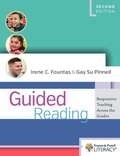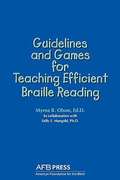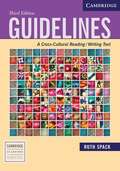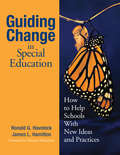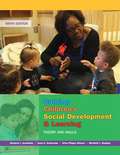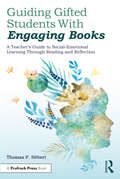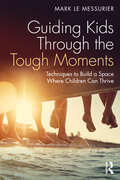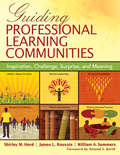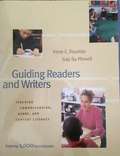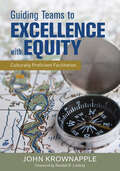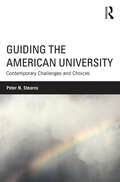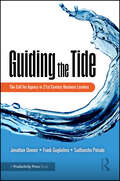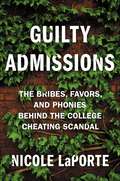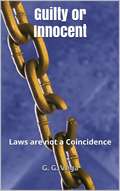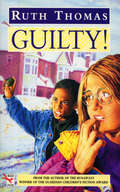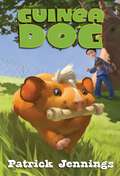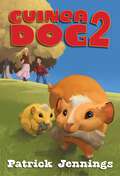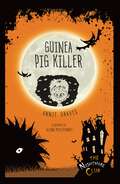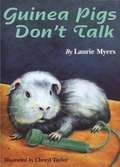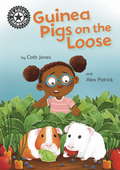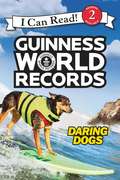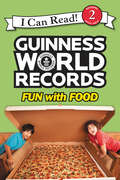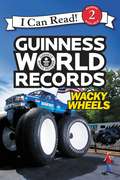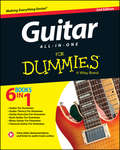- Table View
- List View
Guided Reading: Responsive Teaching Across the Grades (2nd Edition)
by Gay Su Pinnell Irene FountasMuch has been written on the topic of guided reading over the last twenty years, but no other leaders in literacy education have championed the topic with such depth and breadth as Irene Fountas and Gay Su Pinnell. In the highly anticipated second edition of Guided Reading, Fountas and Pinnell remind you of guided reading's critical value within a comprehensive literacy system, and the reflective, responsive teaching required to realize its full potential. Now with Guided Reading, Second Edition, (re)discover the essential elements of guided reading through: a wider and more comprehensive look at its place within a coherent literacy system a refined and deeper understanding of its complexity an examination of the steps in implementation-from observing and assessing literacy behaviors, to grouping in a thoughtful and dynamic way, to analyzing texts, to teaching the lesson the teaching for systems of strategic actions a rich text base that can support and extend student learning the re-emerging role of shared reading as a way to lead guided and independent reading forward the development of managed independent learning across the grades an in-depth exploration of responsive teaching the role of facilitative language in supporting change over time in students' processing systems the identification of high-priority shifts in learning to focus on at each text level the creation of a learning environment within which literacy and language can flourish. Through guided reading, students learn how to engage in every facet of the reading process and apply their reading power to all literacy contexts. Also check out our new on-demand mini-course: Introducing Texts Effectively in Guided Reading Lessons
Guidelines and Games for Teaching Efficient Braille Reading
by Sally S. Mangold Myrna R. OlsonThese unique guidelines and games provide ideas for adapting a general reading program to the needs of braille readers and enriching early instruction in braille that are based on research in the areas of rapid reading and precision teaching. Classroom teachers and anyone working with children who are blind or visually impaired will find this classic handbook an invaluable resource.
Guidelines: A Cross-Cultural Reading/Writing Text (Third Edition)
by Ruth SpackAn advanced reading and writing text designed specifically to strengthen students' academic writing. The cross-cultural readings in Guidelines offer a wide range of thought-provoking subject matter, varying in genre, viewpoint, length, and style. As students respond to the readings and work their way through the writing assignments, they are assisted by strategies laid out in 'Guidelines' boxes and by examples from other student writers. Writing assignments include research writing and essays that synthesize sources, critique arguments, and analyze fiction. A handbook is included as a reference guide in the back of the book. It contains sections on documenting sources, drafting and revising, and correcting grammatical errors. Guidelines, Third edition, is a major revision. The readings have been updated, the chapters are easier to navigate, and the 'Guidelines' now include references to the Internet as a means of research.
Guiding Change in Special Education: How to Help Schools With New Ideas and Practices
by Dr Ronald G. Havelock James L. HamiltonThis practical, step-by-step guide illustrates and describes the seven stages of school change and provides explanations and advice for incorporating each stage into your change process.
Guiding Children's Social Development And Learning: Theory And Skills
by Marjorie Kostelnik Anne Soderman Alice Whiren Michelle RupiperUpdated throughout and featuring an emphasis on NAEYC and other standards, GUIDING CHILDREN'S SOCIAL DEVELOPMENT AND LEARNING: THEORY AND SKILLS, Ninth Edition, provides a comprehensive overview of child guidance and social development. <P><P>Focusing on children from ages birth through 12 years, it provides a seamless transition from the pre-primary to the primary years and addresses the needs of practitioners working with children in a variety of group settings. <P><P>Readers learn how to help children develop social competence and positive feelings about themselves, and how to work with children and families from many different backgrounds and circumstances. <P><P>The book eliminates much of the guesswork and frustration that can hinder practitioners' efforts to influence children's social development and behavior -- providing a unified framework for decision-making and professional practice that incorporates sound principles of children's development, relationship enhancement, and behavior management.
Guiding Gifted Students With Engaging Books: A Teacher's Guide to Social-Emotional Learning Through Reading and Reflection
by Thomas P. HebertGuiding Gifted Students With Engaging Books supports teachers and counselors in facilitating book discussions designed to guide bright young people to self-understanding through high-quality literature. This exciting resource: Covers social-emotional issues in the lives of gifted students. Features examples of lessons and menus of discussion questions for successful book discussions alongside enrichment activities to extend students' learning. Includes an annotated bibliography of children's and young adult books ideal for social-emotional learning. Engaging lessons and activities support learners as they process their feelings regarding issues highlighted in the selected books and class discussion. The book examines this approach with whole classrooms as well as with small groups of students, and features considerations for special populations of gifted students, including twice-exceptional students, culturally diverse students, and children and teens facing serious adversity in their lives.
Guiding Kids Through the Tough Moments: Techniques to Build a Space Where Children Can Thrive
by Mark Le MessurierFamilies, classrooms, all kinds of human groups are intricate, evolving social and emotional worlds. They exist to protect and nourish but living in them is not always easy. And, when one of us is not doing well, none of us are. This makes them a delicate, dynamic, messy, and endless work in progress. This book centres around those moments when we must get involved, or call a child out on an unsafe, careless, or selfish action. Pitched well beyond the superficiality of making "happy families" or "obedient classes," this book dives into the colour and chaos of life. It provides guidance for navigating the commotion and the processes, as well as the grit required in the tougher moments. It’s these moments that reveal what is really happening between children and their parents, educators, or carers. The book outlines a special set of attitudes and skills described as using our "soft eyes and warm hearts." In this space, we hold a child or teen accountable using an almost counterculture mindset. One that connects leadership and strength directly with kindness. This humane approach is more likely to leave young people in a position where they might want to feel responsible, make amends and changes, rather than being forced to. If we are to improve our relationships, outcomes, and futures with this generation of kids we must commit to truthful conversation, reflection, and preparation. Written by trusted author Mark Le Messurier, an experienced teacher, counsellor and public speaker, this is an essential guide for parents, carers, teachers, educational leaders, and allied health professionals responsible for the wellbeing of young people.
Guiding Professional Learning Communities: Inspiration, Challenge, Surprise, and Meaning
by Shirley M. Hord Jim Roussin William A. SommersOffers more than 30 structured "learning opportunities" to help busy educators put six components of effective PLCs into practice and facilitate individual and schoolwide development.
Guiding Readers and Writers, Grades 3-6: Teaching Comprehension, Genre, and Content Literacy
by Gay Su Pinnell Irene C. Fountas<p>Authors Irene Fountas and Gay Su Pinnell have already helped hundreds of thousands of K-3 teachers engage, inform, and inspire early readers and writers. Now, with Guiding Readers and Writers (Grades 3-6), Fountas and Pinnell support teachers on the next leg of the literacy journey, addressing the unique challenges of teaching upper elementary students. <p>The product of many years of work with classroom teachers, Guiding Readers and Writers (Grades 3-6)is one of the most comprehensive, authoritative guides available today. It explores all the essential components of a quality literacy program in six separate sections. </p>
Guiding Teams to Excellence With Equity: Culturally Proficient Facilitation
by John J. KrownappleGuide your school through its cultural proficiency transformation Despite the best efforts of equity leaders, our schools suffer from persistent inequities. Guiding the Journey to Excellence with Equity is a must-read for anyone who supports professional learning in our schools. It defines a process of “inside-out” growth that helps develop culturally proficient educators with the facilitation skills needed to navigate the obstacles that arise during equity transformations. Written with an equity lens, this book: Includes a powerful vignette that illustrates common challenges and solutions Focuses on mental models for managing group energy Is grounded in a systems model for personal and organizational transformation Provides tools for planning culturally proficient learning experiences
Guiding Teams to Excellence With Equity: Culturally Proficient Facilitation
by John J. KrownappleGuide your school through its cultural proficiency transformation Despite the best efforts of equity leaders, our schools suffer from persistent inequities. Guiding the Journey to Excellence with Equity is a must-read for anyone who supports professional learning in our schools. It defines a process of “inside-out” growth that helps develop culturally proficient educators with the facilitation skills needed to navigate the obstacles that arise during equity transformations. Written with an equity lens, this book: Includes a powerful vignette that illustrates common challenges and solutions Focuses on mental models for managing group energy Is grounded in a systems model for personal and organizational transformation Provides tools for planning culturally proficient learning experiences
Guiding the American University: Contemporary Challenges and Choices
by Peter N. StearnsAmerican higher education is under unprecedented pressure, beginning with the public funding and student debt crises and extending to inadequate performance in student retention and growing global competition. Respected educator and scholar Peter N. Stearns breaks down the underlying problems, exploring the most contentious issues for university leaders and administrators today. Guiding the American University covers the major facets of university operation—administration, faculty, and students—and discusses what should be changed and what should be preserved. Covering major topics for debate and real problems facing American higher education today—including the tenure system, online learning, administrative bloat, and campus culture—this book is a critical resource for aspiring and current higher education administrators. Research-based and stemming from a range of case studies, this book’s insightful and fresh recommendations serve as an important contribution to the conversation on the future of American higher education.
Guiding the Tide: The Call for Agency in 21st Century Business Leaders
by Jonathan Donner Sudhanshu Palsule Frank GuglielmoIn a world increasingly driven by artificial intelligence, leadership needs to move beyond the "agile" approach that dominated organizational leadership practices at the end of the 20th century. What is required now for successful leaders is a skillful juxtaposition of proactivity and humility, which we call "guiding the tide." Successful leaders of today must demonstrate personal agency in order to guide the tide of events around them rather than have the tide of events sweep them along. The "tide," like a river within an ocean akin to a gulf stream, is a unique, ever-changing stream of business systems, technology, consumers, and competitors. This book uses storytelling, examples, and clear, everyday language to blend leading-edge psychological research and leadership practices with the authors’ own work in coaching, assessing, and developing leaders for three decades around the world. The book takes the reader on a journey through three major learnings: First, the authors describe the nature of the tide and the demands on leaders to move beyond a reactionary, agile approach toward the forward-leaning, active stance of personal agency. Second, they describe three critical practices to successfully lead with agency and guide the tide: Honest Engagement – the practice of dealing with others from a place of openness, honesty, and a willingness to be vulnerable. Addressing Reality – the practice of seeing the world as it is rather than as we wish it to be, the ability to separate fact from fiction and data from desire. Adaptive Impact – the practice of driving the organization, team, and oneself forward in a way that creates results-beyond- results, that is, delivering goals while building followership, sustainability and "Humanocity" – the integration of human creativity and judgment with the efficiency of digital automation. Third, they offer leaders a practical path to achieving the personal agency to successfully guide their organization through the tide that shapes their world.
Guilty Admissions: The Bribes, Favors, and Phonies behind the College Cheating Scandal
by Nicole LaPorteThis entertaining exposé on how the other half gets in tells the shockingly true story of the Varsity Blues scandal, and all of the crazy parents, privilege, and con men involved.Guilty Admissions weaves together the story of an unscrupulous college counselor named Rick Singer, and how he preyed on the desperation of some of the country's wealthiest families living in a world defined by fierce competition, who function under constant pressure to get into the "right" schools, starting with pre-school; non-stop fundraising and donation demands in the form of multi-million-dollar galas and private parties; and a community of deeply insecure parents who will do anything to get their kids into name-brand colleges in order to maintain their own A-list status. Investigative reporter Nicole LaPorte lays bare the source of this insecurity—that in 2019, no special "hook" in the form of legacy status, athletic talent, or financial giving can guarantee a child's entrance into an elite school. The result is paranoia, deception, and true crimes at the peak of the American social pyramid. With a glittering cast of Hollywood actors—including Felicity Huffman and Lori Loughlin—hedge fund CEOs, sales executives, and media titans, Guilty Admissions is a soap-opera-slash-sneak-peek-behind-the-curtains at America's richest social circles; an examination of the cutthroat world of college admissions; and a parable of American society in 2019, when the country is run by a crass tycoon and all totems of status and achievement have become transactional and removed from traditions of ethical restraint. A world where the rich get whatever they want, however they want it.
Guilty or Innocent
by Richard Taylor G. G. VegaLaws are not implemented by God's or the authorities' wickedness, they exist to preserve and protect each individual's or group of people's rights. Human beings lack the capability to ensure a natural and spontaneously just or correct behaviour. Many people are behind bars, but it is most likely that during their childhood and youth, it was never their intention to wind up in such sad condition. One of the most valuables factors in life is freedom, sadly many lose it, because they have mistaken freedom for licentiousness, and that path generally leads towards jail, personal corruption or death itself. This book's purpose is to help you grasp how valuable your life and your freedom are, regardless or your current social condition.
Guilty!
by Ruth ThomasThere's been a spate of break-ins lately in the area and everyone in Kate's class is saying that the burglar is Desmond Locke's dad because he's just come out of prison. Everyone, that is, except Kate. She's sure that Mr Locke is innocent and turns to her Secret Seven books for inspiration - they always find the real thief. Kate and Desmond become detectives to find out the truth and prove Desmond's dad is innocent. But the truth isn't always what you would like it to be and Kate is horrified when she discovers who really is... GUILTY.
Guinea Dog (Guinea Dog #1)
by Patrick JenningsRufus has been dreaming of getting a dog. His best friend has one. His worst friend has one. But his dad has a few objections: They whine. They gnaw. They bark. They scratch. They beg. They drool. Rufus pays no attention when his mom offers her think-outside-the-box suggestion, because she can't be serious. She can't be. She can be. And she actually comes home with a guinea pig. And if Rufus's dad thinks dogs are a problem, he won't know what hit him when he meets the Guinea Pig That Thinks She's a Dog. She barks. She bites. She'll eat your homework.
Guinea Dog 2 (Guinea Dog #2)
by Patrick JenningsReaders who loved Guinea Dog have been sitting, begging, and rolling over for a sequel. The beloved Patrick Jennings returns with the follow up to his award-winning and state list hogging title! When his classmates learn about Fido, the guinea pig that acts like a dog, they all want a piece of Rufus, her owner. But Rufus hates the attention, the demands, the "celebrity." So he decides to make Fido learn how to be an actual guinea pig. But when she goes missing, he feels terrible. Was she lost, "dognapped," or did she run away, because he no longer liked her just the way she was? Offering the same offbeat humor and pacing of the first Guinea Dog, this novel will prove to be a reader's best friend.
Guinea Pig Killer (The Nightmare Club #4)
by Annie GravesThe Nightmare Club is not for just ANYBODY. Only the spookiest, scariest stories get told at Annie's Halloween sleepovers—and if you can't take it, well, tough! Sandy hates his sister's guinea pig. No way is he taking care of Princess Snowflake while the rest of the family's away. After all, dead pets tell no tales... Or do they?
Guinea Pigs Don't Talk
by Laurie MyersOn Lisa's first day at a new school, she and a bossy classmate begin playing a series of tricks on each other, using the class guinea pigs.
Guinea Pigs on the Loose: Independent Reading 11 (Reading Champion #507)
by Cath JonesBecks has the responsibility of looking after the school guinea pigs for the weekend. She looks after them well, but those guinea pigs are just too tempted by next door's garden!Reading Champion offers independent reading books for children to practise and reinforce their developing reading skills.Fantastic, original stories are accompanied by engaging artwork and a reading activity. Each book has been carefully graded so that it can be matched to a child's reading ability, encouraging reading for pleasure.Independent Reading 11 stories are the perfect introduction to first chapter books for children aged 6+ who are reading at book band 11 in classroom reading lessons.
Guinness World Records: Daring Dogs (I Can Read Level 2)
by Cari MeisterA brand-new Guinness World Records book for kids!Sit, speak, roll over. Surf, recycle, scooter? No, we’re not wagging your tail! Dogs of all breeds and sizes are impressive. From heroic rescues to zany tricks, the awe-inspiring pooches in Daring Dogs have gone above and beyond to earn their Guinness World Records. Simple text and full-color photos will make learning about exciting topics fun for beginning readers.Guinness World Records: Daring Dogs is a Level Two I Can Read book, geared for kids who read on their own but still need a little help.
Guinness World Records: Fun with Food (I Can Read Level 2)
by Christy WebsterA brand-new Guinness World Records book for kids!We hope you’re hungry! Fun with Food has plenty of options to whet your appetite: the largest grilled cheese, the tallest cake, the most expensive hot dog, and more. Simple text and full-color photos will make learning about exciting topics fun for beginning readers.Guinness World Records: Fun with Food is a Level Two I Can Read book, geared for kids who read on their own but still need a little help.
Guinness World Records: Wacky Wheels (I Can Read Level 2)
by Cari MeisterA brand-new Guinness World Records book for kids!Buckle up! The Guinness World Record holders in Wacky Wheels cover all the vehicles that roll along. From the largest monster truck to the loudest bike horn, these Guinness World Records will rev the engines of imagination. Simple text and full-color photos will make learning about exciting topics fun for beginning readers.Guinness World Records: Wacky Wheels is a Level Two I Can Read book, geared for kids who read on their own but still need a little help.
Guitar All-In-One For Dummies
by Hal Leonard Corporation Mark Phillips Jon Chappell Desi SernaMake your music come alive with this indispensable guitar guide There's no denying that guitar players have cachet. The guitar is an ever-present part of our collective musical heritage, and the sound can be sensual, aggressive, or a million things in between. Whether you're hoping to conquer Free Bird, Bourée, or Bolero Mallorquin, you need to learn to walk before you can run. Even once you can run, you need something to help you clear hurdles along the way. That's where Guitar All-In-One For Dummies, 2nd Edition, comes in. It's your complete compendium of guitar instruction, written in clear, concise For Dummies style. It covers everything from positioning and basic chords to guitar theory and playing styles, and even includes maintenance advice to keep your instrument sounding great. It's an amazing resource for newbies and veterans alike, and offers you the opportunity to stretch beyond your usual genre. Forge the sound of rock, blues, classical, and more Understand the music theory behind guitar mastery Express yourself through your own compositions Perform practice exercises for muscle memory and dexterity Guitar All-In-One For Dummies, 2nd Edition, includes access to audio tracks and instructional videos to guide you through the lessons and inspire you to play often, which is the number-one key to success. You get advice and instruction from some of the most respected guitar teachers in the business, plus online resources, for less than the cost of a single lesson. Guitar All-In-One For Dummies, 2nd Edition, is the key to bringing your music to life.
